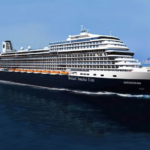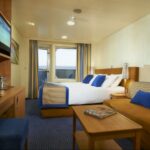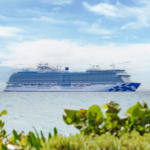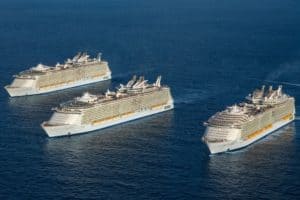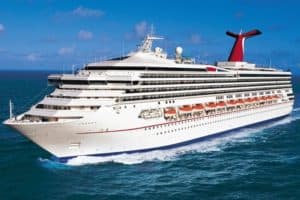The word Titanic evokes thoughts of something epic and gigantic in proportion. When we hear this word, the first thing that comes to our mind is the infamous and ill-fated ship, the RMS Titanic. But how big was the Titanic compared to a cruise ship built today?
How big was the Titanic compared to a cruise ship built today? Compared to a modern-day cruise ship, the Titanic was quite small. Modern-day cruise ships, such as the Oasis-class line of cruise ships, are about a third longer and about twice the width of the Titanic.
The RMS Titanic was 882 feet (269 meters) long and 92 feet (28 meters wide). Modern-day cruises, such as the Oasis-class cruise ships, measure more than 1,180 feet (360 meters) and more than 200 feet (61 meters) wide.
Two other popular, modern-day cruise ships are measured as follows:
The Allure of the Seas measures 1,187 feet (362 meters) long and 215 feet (66 meters) wide. The Symphony of the Seas spans 1,184 feet (361 meters) long and 215 feet (66 meters) wide.
The below image shows the difference between the Titanic and two modern-day cruise ships: the Allure of the Seas and the Costa Concordia.

The Titanic could hold up to 3,327 passengers. As a comparison, the modern-day Symphony of the Seas cruise ship can hold up to 6,780 passengers – nearly twice as much as the Titanic.
Read on to learn more about how big was the Titanic compared to a cruise ship built today, including differences between the old and new ships.
How Big Was the Titanic Compared to a Cruise Ship Built Today?
At the time it was launched, the RMS Titanic was the largest seagoing vessel ever built. Its immensity is the stuff of legend up until now. However, since much larger modern ships have been constructed, the Titanic has dwarfed in size.
But how big was the Titanic compared to a cruise ship in the modern age? In the 21st century, the three largest modern cruise ships are Royal Caribbean International’s Oasis-class ships: the Oasis of the Seas, the Allure of the Seas, and the Symphony of the Seas.

Size Comparison – Titanic vs Modern Cruise Ship
How big was the titanic compared to a cruise ship built in modern times? In terms of length, Oasis-class cruise ships measure more than 1,180 feet, making them around 304 longer than the Titanic. To be precise, the Oasis of the Seas, brought into service in 2009, spans 1,186.5 feet (361.6 meters) in length. The Allure of the Seas, which first set sail in 2010, measures 1,187 feet (362 meters), only 2.0 inches (50 millimeters) longer than the Oasis. The Symphony of the Seas, constructed in 2018, is the shortest of the three at 1,184.42 feet (361.011 meters).
The Titanic had a beam or width of 92 feet and 6 inches (28.2 meters), which would remain consistent among cruise ships until the launch of the Queen Mary 2 in 2004. It had a width of 148 feet, which was wider than the Titanic by 55 feet.
In comparison, the Oasis and the Allure share a beam of 198 feet (47 meters), more than double the Titanic’s width. The Symphony of the Seas has the largest beam of them all, with a width of 215.5 feet (66 meters).
Built with a total of nine decks, the Titanic rose to a height of 175 feet (53.3 meters), about equal to the size of an 11-story building. The Oasis and the Allure both have 18 decks (16 for passengers), making up a total height of 236 feet (72 meters) above the waterline. Again, the Symphony of the Seas towers over the rest, with 18 decks and a height of 238 feet (72.5 meters). It is roughly the equivalent of a 22-story building.
In Terms of Capacity
Now, what about its capacity? Gross tonnage (GT) is the total molded volume of the enclosed spaces of a ship, calculated by measuring it from the keel to the funnel, the stern to the bow, and to the outside of the hull framing. It is a replacement for gross register tonnage (GRT), the unit of measurement used during the time of the Titanic. At that time, the Titanic had a GRT of 46,328.
The Oasis and the Allure have a common gross tonnage of 225,282 GT. Additionally, their net tonnage (NT), the total molded volume of a ship’s cargo spaces are 257,429 and 242,999, respectively.
As for their deadweight tonnage (DWT), which is the amount of weight that a ship can carry, the Oasis has a DWT of 15,000, while the Allure has 19,750 DWT. The Symphony of the Seas’ GT is five times larger than that of the Titanic at 228,081, while its NT is 258,794, and its DWT is 18,095.
As for passenger capacity, the Titanic could carry 2,435 passengers and a crew of 892 people, for a total of 3,327 people. The Oasis and the Allure have a capacity of 5,484 passengers at double occupancy with a maximum of 6,780 passengers. A 2,200-person crew also oversees them. The Symphony of the Seas holds the most passengers. It can carry 5,518 passengers at double occupancy and 6,680 at maximum, with a crew of 2,200 people.
In Terms of Speed
In finding out how big the Titanic was compared to a cruise ship, we should also consider how fast it was. Let’s see if its size might have somehow played a factor regarding its speed.
As previously mentioned, the Titanic wasn’t really built with speed in mind. In any case, ocean liners and cruise ships don’t usually require too much speed as they travel slowly from port to port in a span of days rather than hours. So, the Titanic only had a cruising speed of 21 knots (39 kilometers per hour, 24 miles per hour) and could achieve a maximum speed of 24 knots (44 kilometers per hour, 28 miles per hour).
Modern cruise ships are built much larger than the Titanic, but their size has little bearing on their speed. The Oasis of the Seas’ cruising speed is only a little higher than the Titanic’s maximum speed at 24.5 knots (45.4 kilometers per hour, 28.2 miles per hour). The Allure of the Seas has a cruising speed of 22.6 knots (41.9 kilometers per hour, 26.0 miles per hour), while the Symphony of the Seas is just a tiny bit lower at 22 knots (41 kilometers per hour, 25 miles per hour).
A speed of 22 knots happens to be the average speed permitted for cruise ships since 1912 and has been practiced for safety reasons, including minimizing fuel consumption.
In Terms of Other Features and Amenities
Perhaps the Titanic may not seem too impressive by modern standards, but it was considered the most lavish and majestic passenger ship of its time. It was constructed to be a high-class hotel on the sea, with interiors designed in the neoclassical empire style of architecture.
The Titanic had several amenities. They are as follows:
- A 7-foot deep swimming pool
- A gymnasium
- A squash court
- An electric bath
- A steam room
- A cool room
- A hot room
- A massage room
- A smoking room
- A reading and writing room
- An à la carte restaurant
- A 600-seat dining saloon
- A French café
- The Verandah café with actual palm trees
- Four elevators
Since today’s cruise ships are built much bigger, you can expect them to be packed with even more features than the Titanic ever did. While the Titanic may have been conceived as a floating hotel, the three Oasis-class cruise ships are practically cities on water. Each of these ships has seven neighborhoods that cater to their passengers’ every whim and needs.

The Boardwalk
The Boardwalk, located on deck 6 of each ship, is a fun-filled amusement area for the whole family, capturing the ambiance of traditional seaside piers, such as Coney Island and Atlantic City. Passengers are greeted by a full-sized musical carousel, adding to this neighborhood’s wholesome carnival atmosphere.
Other attractions include two 43-foot rock-climbing walls and an 82-foot high zip line, including various eateries, bars, and specialty shops. Another special attraction is the AquaTheater, an amphitheater with a 17-foot deep pool, where audiences can watch synchronized swimming and aquatic acrobatic performances, as well as dancing fountains and light shows.
Central Park
Central Park, found on deck 8, is the ships’ onboard open-air park. This area replicates the look and feel of a city park with more than 12,000 actual trees and plants. It also has four restaurants, two bars, and three retail shops, including an art gallery and a portrait studio. It’s undoubtedly an ideal and idyllic place to relax and unwind.
The Royal Promenade
The Royal Promenade is actually the first of the neighborhoods that passengers will encounter upon boarding an Oasis-class ship. Located on deck 5, just below Central Park, the three-deck-high Royal Promenade is the ship’s mall area. Also, this neighborhood is lined with eight retail shops, three restaurants, and six bars.
Its most unique bar is The Rising Tide, an elevator bar with a 32-person capacity. This bar slowly moves up and down between Central Park and the Royal Promenade.
The Entertainment Place
The Entertainment Place occupies the entirety of deck 4 and is easily accessed from the Royal Promenade. The entertainment center of the ship, this vibrant neighborhood, has a large casino and several bars and nightclubs. It also has an ice-skating rink and a theater that hosts live performances, plays, concerts, and even 3D movies.
The Vitality Spa and Fitness Center
The Vitality Spa and Fitness Center, also found on deck 6, is a large onboard facility for physical, mental, and spiritual wellness. It has 29 treatment rooms, three massage rooms, a thermal suite with heated benches and steam rooms, a beauty salon, a medi-spa for acupuncture treatments, and an enrichment lounge for wellness lectures.
There is also a fitness center equipped with 158 exercise machines and holds classes for kickboxing, yoga, and Pilates. A retail shop is also available, including the Vitality Café, which serves healthy snacks, sandwiches, fruits, and smoothies.
The Youth Zone
The Youth Zone is the section of the ship where child passengers can hang out. This section covers more than 28,000 square feet, divided into two areas designated for particular age groups.
The Adventure Ocean area, located on deck 14, is for children ages 6 months to 12 years old, while the Youth Zone Teen area on deck 15 is for teens ages 13 to 17. Also found in the Youth Zone is a play area, a science lab, a workshop for family activities, the Imagination Studio, and the Adventure Ocean Theater.
The Pool and Sports Zone
The Pool and Sports Zone, occupying decks 15 and 16, is a vast area for outdoor activities, such as swimming and jogging.
It comes with four different swimming pools: the beach pool, the main pool, the H2O Zone (a family water park), and the Sports Pool, which is reserved for lap swimmers in the morning and water sports during the afternoon.
There are also 10 whirlpools, a miniature golf course, two surf simulators, and a Sports Court for basketball, volleyball, and soccer. Aside from these amenities, the Pool and Sports Zone also has four restaurants, six bars, and a tranquil adults-only pool section, the Solarium.
A Brief History of the Titanic
The RMS Titanic was conceived in the late 1900s by J. Bruce Ismay, chairman of the British shipping company, the White Star Line. The Titanic was meant to rival the Lusitania and the Mauretania. These ocean liners were two of the largest and fastest passenger ships at that time. But Ismay chose to compete with these ships in terms of size rather than speed, with an emphasis on comfort and luxury.
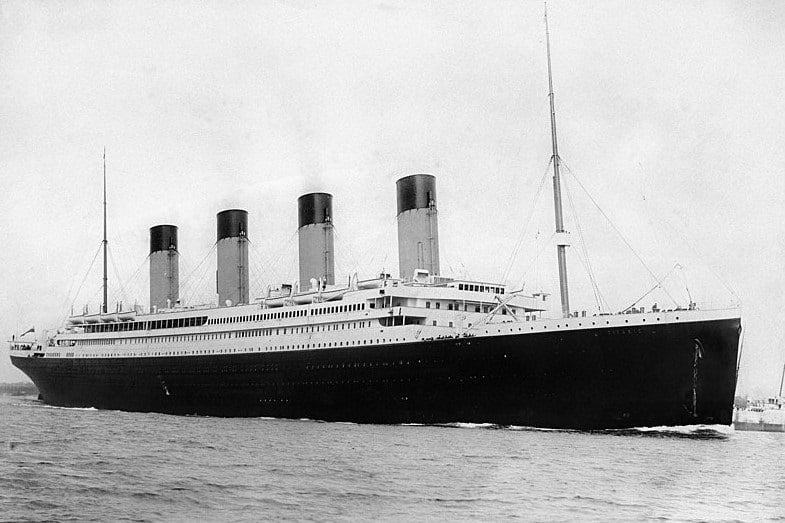
When the Titanic was completed in 1912, it had a length of 882 feet (269.1 meters), which surpassed Lusitania’s length at 787 feet (239.9 meters), having a difference of almost 100 feet. The Titanic was second of the three Olympic-class ocean liners overseen by the White Star Line. The first was the RMS Olympic, which was completed in 1911.
Before the Olympic was dethroned by its sister ship, it actually held the record as the largest ocean liner in the world. In fact, the Olympic and the Titanic had the same dimensions. But the latter’s revised interior configurations gave it a higher gross tonnage.
The Disaster
At that time, the Titanic’s reign as the largest ship afloat became a short one, as was its time in service. It made its maiden voyage on April 10, 1912, and only sailed for a mere five days before the fatal collision that caused it to sink in the North Atlantic Ocean in the early morning of April 15, 1912.
The 882-foot vessel was done in by an iceberg, reportedly measuring around 200 to 400 feet long and 50 to 100 feet high. The Titanic sank for approximately 2 hours and 40 minutes. The ship had 20 lifeboats with a 65-person capacity, enough to carry 1,178 people. Of the 2,229 passengers aboard, only 713 survived.
The HMHS Britannic
In 1915, three years after the Titanic’s demise, construction was completed on its sister ship, the HMHS Britannic. It was the third of the White Star Line’s Olympic-class ocean liners. At a length of 890 feet and 3 inches (271.35 meters), the HMHS Britannic was a bit larger than the Titanic and the Olympic.
The Britannic also had a relatively short life after putting into service as a hospital ship during World War I. A naval mine sank it on November 21, 1916, less than a year after its maiden voyage. It was regarded as the largest ocean liner wreck in the world, with its sibling the Titanic placed as the second largest.
Nonetheless, the Titanic’s status as the largest ocean liner of its time would forever be etched in history. But as time marched on, many passenger ships were largely built than the Titanic. One of which was the RMS Queen Mary, which was brought to service in 1936. It spanned a length of 1,019.4 feet (310.7 meters), surpassing the Titanic by 136 feet.
Conclusion – How Big Was the Titanic Compared to a Cruise Ship?
So, how big was the Titanic compared to a cruise ship built in today’s modern age? The answer that comes up is simply–not very big.
Compared to a modern-day cruise ship, the Titanic was fairly small. Modern-day cruise ships, such as the Oasis-class cruise ships, are about a third longer and about double the width of the Titanic.
In terms of length, the Oasis-class cruise ships measure more than 1,180 feet (360 meters), making them around 304 feet (93 meters) longer than the 882-foot (269 meters) RMS Titanic.
The Oasis-class ships we have reviewed are big enough to contain the Titanic itself. Despite this, because of Titanic’s place in history, it will always remain as the largest ship ever built, at least in our collective memory, but not in actual fact.
Related reading:
What Is the Largest Cruise Ship in the World?

